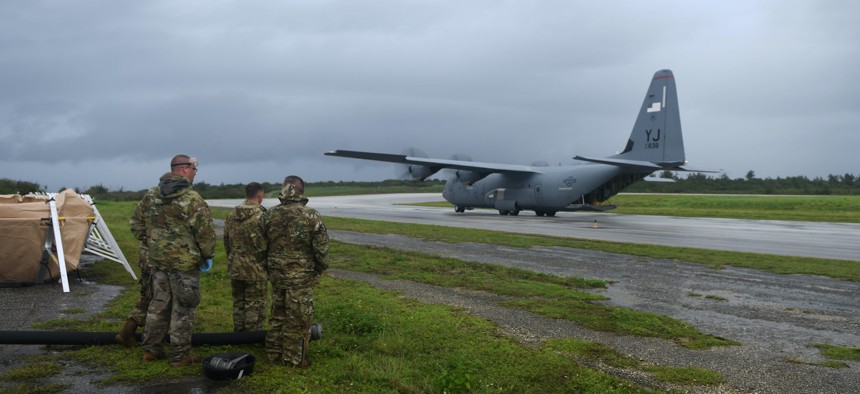
U.S. Air Force airmen prepare to off-load fuel from a C-130J Super Hercules, July 21, 2021, at Tinian International Airport, Tinian, during an agile combat employment exercise. U.S. Air Force / Tech. Sgt. Benjamin Sutton
Air Force expanding number of bases in Pacific over next decade
But the exact number depends on how much money the service gets in the future.
The U.S. Air Force will increase its number of bases across the Pacific over the next decade, in an effort to spread out and become more survivable in conflict.
The service’s bases “will grow in increments that are visible through time, across probably two or three [future years defense programs] as we work through that,” said Brig. Gen. Michael Zuhlsdorf, the service’s deputy director of resource integration for engineering, logistics, and force protection.
But the total number of bases is dependent on how much funding the Air Force receives, Zuhlsdorf said Tuesday at the Mitchell Institute.
“You think about island chains that are either in the first island chain, there are some bases that are already set there, and then the second island chain, which is basically Guam, and all of those regions in there and so there's a number of different airfields that we're working through, and based on the resourcing that number will shift,” Zuhlsdorf said.
The Air Force has done analyses to figure out which bases could be used to “generate an air tasking order” based on the number of “spokes” in the area, Zuhlsdorf said. The service uses the term “hub-and-spoke” to describe bases in its Agile Combat Employment concept, or ACE, which was created to make the service more mobile in the Pacific.
In the ACE concept, a few airfields serve as central ports, or hubs, while several smaller airfields serve as spokes. The idea is to be able to distribute weapons and assets over a large area and to increase survivability, versus just having a few large airfields throughout the geographically enormous region.
But while there is general direction on ACE in the Pacific—where the concept originated—the service is leaving it up to individual commanders to institutionalize the concept, said Col. James Hartle, associate director of logistics, deputy chief of staff for logistics, engineering, and force protection.
“We really allow our units to try and define that for themselves. We've got a little bit of overarching guidance, now from the air staff to try to formalize the training for that, but ultimately we are putting the onus on our commanders [who] are in the field to execute their mission the best way that they know how, and obviously allowing us to get their requirements and working through that organized training and equipping element a little bit,” Hartle said.
Implementing the concept in the Pacific will look different from unit to unit, Hartle said, as each has different weapon systems and different locations they’ll be operating from.
“I think it's really a unique way that ACE has kind of evolved in really allowing the units to execute, grab those lessons learned, provide some guidance, but not so directive in nature that the left-right boundaries to do that are so tight that it's ineffective,” Hartle said.
The service has also been practicing its ACE concept outside of the Pacific—like when it recently surged fighters to U.S. Central Command to combat Russian aggression, said Col. Patrick Launey, chief of the logistics readiness division.
“We look at operations in Europe and the Middle East recently, CENTCOM and EUCOM, where the United States Air Force and Space Force was providing support. There were a lot of situations where we were employing aspects of agile combat employment into how we were going to posture and conduct operations,” Launey said.




